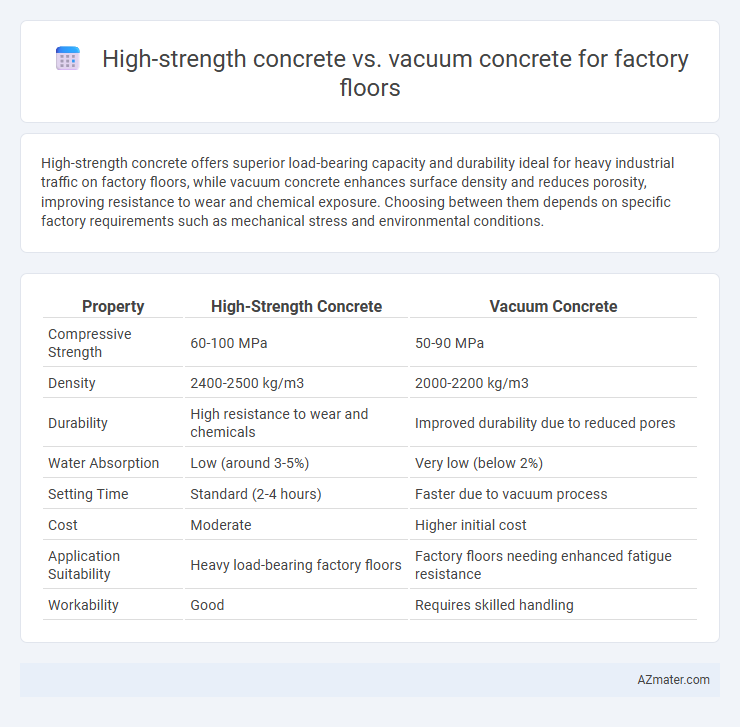High-strength concrete offers superior load-bearing capacity and durability ideal for heavy industrial traffic on factory floors, while vacuum concrete enhances surface density and reduces porosity, improving resistance to wear and chemical exposure. Choosing between them depends on specific factory requirements such as mechanical stress and environmental conditions.
Table of Comparison
| Property | High-Strength Concrete | Vacuum Concrete |
|---|---|---|
| Compressive Strength | 60-100 MPa | 50-90 MPa |
| Density | 2400-2500 kg/m3 | 2000-2200 kg/m3 |
| Durability | High resistance to wear and chemicals | Improved durability due to reduced pores |
| Water Absorption | Low (around 3-5%) | Very low (below 2%) |
| Setting Time | Standard (2-4 hours) | Faster due to vacuum process |
| Cost | Moderate | Higher initial cost |
| Application Suitability | Heavy load-bearing factory floors | Factory floors needing enhanced fatigue resistance |
| Workability | Good | Requires skilled handling |
Introduction to High-Strength and Vacuum Concrete
High-strength concrete exhibits compressive strengths typically exceeding 6,000 psi, making it ideal for factory floors requiring durability under heavy machinery and frequent traffic. Vacuum concrete reduces porosity through a vacuum dewatering process, enhancing density and minimizing water content to improve load-bearing capacity and resistance to wear. Both solutions optimize structural integrity, with high-strength concrete focusing on compositional enhancements and vacuum concrete emphasizing microstructure refinement for industrial flooring applications.
Key Properties of High-Strength Concrete
High-strength concrete offers exceptional compressive strength exceeding 6000 psi, making it ideal for factory floors subject to heavy machinery and high traffic loads. Its low permeability enhances durability by resisting chemical attacks, abrasion, and wear, ensuring long-lasting performance in industrial environments. Additionally, the reduced water-cement ratio and optimized aggregate grading in high-strength concrete contribute to superior shrinkage control and dimensional stability, critical for maintaining smooth and crack-resistant factory floor surfaces.
Characteristics of Vacuum Concrete
Vacuum concrete, designed for high-density and low porosity, uses a vacuum dewatering process to remove excess water rapidly, resulting in a stronger and more durable surface ideal for factory floors subjected to heavy loads and high traffic. Its enhanced compressive strength and reduced drying shrinkage improve resistance to wear, chemicals, and abrasion compared to conventional high-strength concrete. This makes vacuum concrete an optimal choice for industrial flooring requiring superior mechanical performance and longevity under demanding operational conditions.
Comparative Strength and Durability
High-strength concrete typically achieves compressive strengths above 6,000 psi, providing excellent load-bearing capacity for heavy machinery and industrial traffic in factory floors. Vacuum concrete, produced through vacuum dewatering techniques, features reduced water content and denser microstructure, resulting in superior durability and enhanced resistance to abrasion, chemical attacks, and freeze-thaw cycles. Comparative analysis shows vacuum concrete offers longer service life and lower maintenance costs due to its improved density and minimized pore connectivity, while high-strength concrete primarily excels in initial load resistance.
Installation Process and Time Efficiency
High-strength concrete offers a straightforward installation process with standard curing times typically ranging from 7 to 28 days, allowing for reliable scheduling in factory floor applications. Vacuum concrete utilizes a vacuum dewatering technique that accelerates strength gain and reduces drying time by removing excess water, enabling faster floor use and minimizing operational downtime. The vacuum concrete installation involves specialized equipment and trained personnel but delivers significant time efficiency benefits compared to traditional high-strength concrete methods.
Surface Finish and Resistance to Wear
High-strength concrete offers superior compressive strength and a dense surface finish, improving durability and resistance to surface wear in factory floors under heavy machinery loads. Vacuum concrete enhances surface quality by removing entrapped air and reducing porosity, resulting in a smoother finish and increased resistance to abrasion and chemical exposure. Both materials optimize factory floor longevity, with vacuum concrete providing enhanced surface integrity while high-strength concrete delivers greater load-bearing capacity.
Cost Implications and Material Efficiency
High-strength concrete offers cost advantages through its higher compressive strength, reducing the required slab thickness and thereby lowering material use and labor expenses on factory floors. Vacuum concrete enhances material efficiency by improving compaction and eliminating air voids, resulting in superior durability and reduced long-term maintenance costs despite its higher initial investment. Evaluating the total cost of ownership, high-strength concrete delivers upfront savings, while vacuum concrete provides better performance and lifespan value for industrial flooring applications.
Maintenance and Long-Term Performance
High-strength concrete offers excellent compressive strength and durability, making it suitable for factory floors subjected to heavy machinery and constant load, resulting in lower maintenance needs over time. Vacuum concrete enhances density and reduces porosity through air removal, improving resistance to chemical attacks and moisture intrusion, which extends the floor's lifespan and reduces long-term repair costs. Both options provide durable performance, but vacuum concrete's improved microstructure often leads to superior maintenance efficiency and longevity in harsh industrial environments.
Sustainability and Environmental Impact
High-strength concrete offers enhanced durability and load-bearing capacity, reducing the need for frequent repairs and lowering long-term environmental impact through extended service life. Vacuum concrete, by incorporating vacuum dewatering techniques, improves density and reduces water content, leading to decreased material usage and energy consumption during curing, which contributes to sustainability. Both options present eco-friendly benefits, but vacuum concrete's water-efficient process aligns more closely with stringent environmental standards for factory floor applications.
Choosing the Best Concrete Type for Factory Floors
High-strength concrete offers superior compressive strength ideal for heavy machinery and high traffic in factory floors, ensuring long-term durability and resistance to wear. Vacuum concrete enhances density and reduces voids by removing excess water, improving resistance to chemical spills and abrasion common in industrial environments. Selecting the best concrete involves evaluating load requirements, exposure conditions, and maintenance needs to balance strength, durability, and cost-effectiveness for factory floor applications.

Infographic: High-strength concrete vs Vacuum concrete for Factory floor
 azmater.com
azmater.com